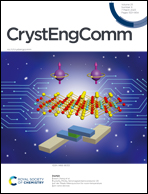Self-assembly of secondary aryl amides in cocrystals with perfluoroaryl coformers: structural analysis and synthon preferences†
Abstract
Cooperation of aryl⋯perfluoroaryl stacking interactions and hydrogen bonds was utilized in the construction of six novel cocrystals of aromatic cis-amides with pentafluorobenzoic acid (pfba) and pentafluorophenol (pfp). They were obtained by crystallization from solution and structurally characterized. In four instances, the components form heterotetrameric motifs, in which amide:amide homodimer interacts symmetrically on two sides via hydrogen bonds with coformer molecules (pfba or pfp). In general, in these cocrystals the main synthon is maintained regardless of which coformer is used. For phenanthridin-6(5H)-one (in which the amide group is more sterically hindered compared to other studied lactams) different patterns were observed. Its cocrystallization with pfba led to the formation of heterodimeric units, whereas combination with pfp gave quite unique crystal structure where pfp molecules were incorporated between the lactam homodimers. Also, the accessibility of oxygen atoms of the lactam dimers to form hydrogen bonds was evaluated using molecular electrostatic potential (MEP).



 Please wait while we load your content...
Please wait while we load your content...